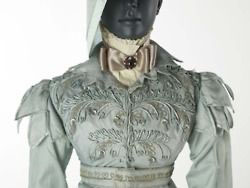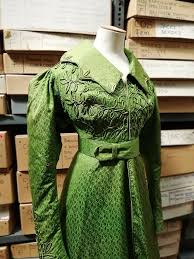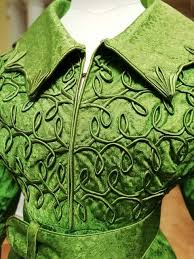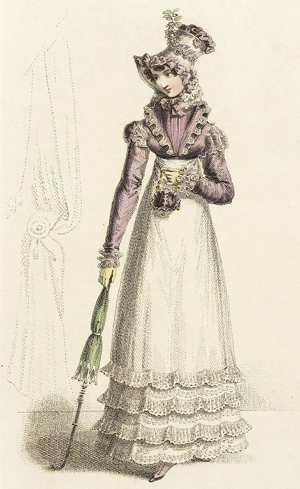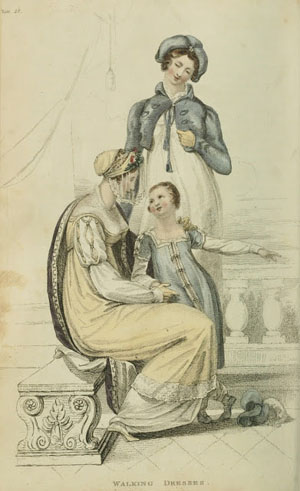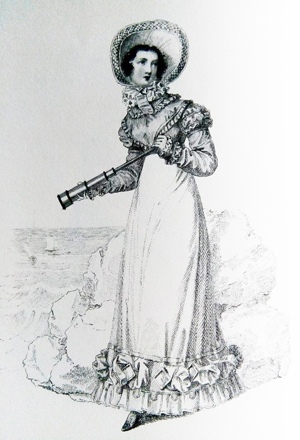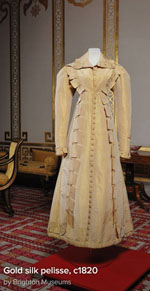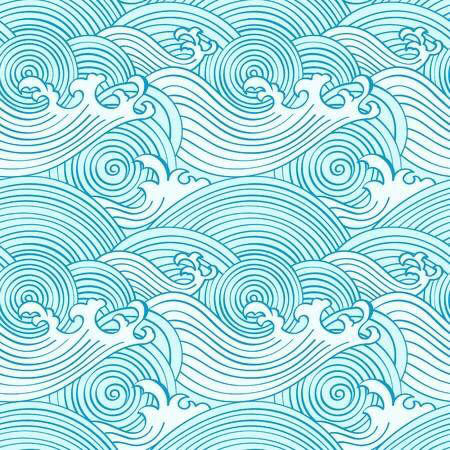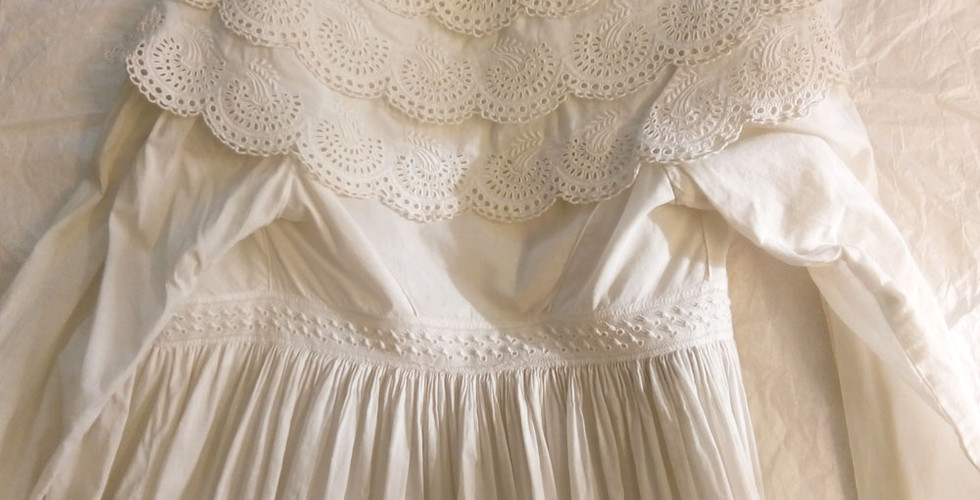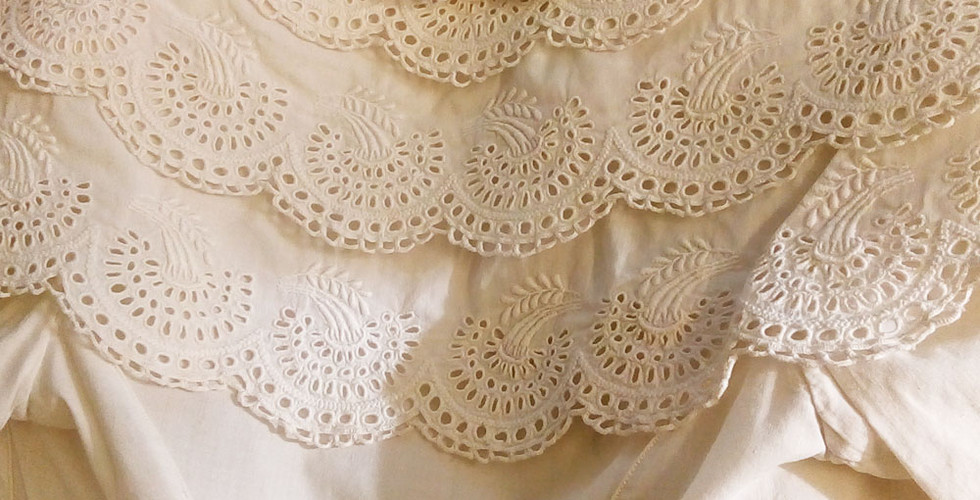The Regency Wardrobe collection - research & making - Dressed for promenading
- Stephanie Smart HoEP
- Jun 14, 2020
- 19 min read
Updated: Sep 22, 2021

Walking in Regency England
"Walking Dresses were worn to see and be seen. They are often referred to as Promenade Dresses, a very literal definition of their purpose. The fashionable Regency woman was seen walking in the parks or in the shopping districts during the London Season (spring and early summer); at the popular seaside resorts in August and September; and in the countryside at their own estates or at house parties during the fall and winter months. Walking Dresses differ for each location and season of the year. Because they were meant to be worn outdoors, the full costume of the Walking Dress always included a head covering of some kind, an outer garment or wrap, and gloves. Bonnets, caps, and veils were worn to cover the head, and were often the means of the most dashing or frivolous fashion statement".
As an interesting aside I smiled when I came across this image of a woman taking snuff before a walk
Imagine if you will setting out for a walk in Brighton, from Brunswick square, in the late 1820's. Of course you would likely head along the sea front in front of the townhouses that look out to sea, therefore toward the Chain pier; promenading along the promenade so to speak. But in the early days of its existence Brunswick square was right on the edge of Brighton & Hove. So if you had turned right instead of left you would have walked straight into a green landscape, whilst yet staying beside the blue horizon. As this image shows:

© The Regency Society & the Society of Brighton Print Collectors - please see: http://sbpc.regencysociety.org/view-of-brunswick-square-and-adjacent-buildings-adjoining-brighton/
And if you were female and the weather was a little chilly you might be wearing a floor length pelisse.
As is evident in the quote from janeausten.co.uk above the term "walking dress" seems included the outer layers, jackets, cloaks, wraps etc, that a woman would have worn whilst walking. These outer garments were often made from colourful fabrics, while the dress beneath was commonly white during this period. Earlier styles of jacket include one coincidentally (considering where our imaginary character is walking) called the Brunswick, please see: https://collections.vam.ac.uk/item/O115756/brunswick-unknown/ but by the early nineteenth century fashion would more surely have dictated that a Spencer or a Pelisse be worn
For more about the history of the Pelisse please see my earlier post: https://stephaniesmart.wixsite.com/stephaniesmart/single-post/2018/11/26/Pelisse
Loops, Buttons and Trim
I found this wonderful sky blue example early on in my research and became absolutely enamoured by it (there seems to be a green version in existence also). It's owned by the museum of London: https://collections.museumoflondon.org.uk/online/object/82460.html and covered in, what I would go on to discover, was called rouleaux work. I also went on to find other examples of beautiful rouleaux work but few seemed quite to compare.
Rouleaux is usually made from fabric of course, by sewing together the edges of a long strip and then turning it inside out. Please see: https://fabricnfiction.com/tag/regency-dress/
Making garments from paper means that many fabric techniques have to be adapted and I'm very grateful to Gilly Burton for all the time she spent working out the best way to create reams of paper rouleaux for the front of Loops, Buttons and Trim, part of The Regency Wardrobe collection.

Image of the middle of Loops, Buttons and Trim showing the paper rouleaux
Working and finished photos of the Loops, Buttons and Trim showing the paper rouleaux being applied. For more images please click right
Rouleaux credit to Gilly Burton, Jenny Fraser, Kerry Crofton

In the past I've always banned the inclusion of any material other than thread and paper (but including card) in the making, or even in the display, of any of the garments I've made. But I have found it very interesting, during my research into historical fashion, including whilst looking at real pieces in museum and private collections (for more on this please see: https://stephaniesmart.wixsite.com/thehiddenwardrobe), to consider how real garments were held together. And pins were commonly used not just during construction but whilst pieces were actually being worn, to hold them on the body.
"Pins were so essential to the 18th c. lady that the British trade embargoes against American colonists during the Revolution made their price skyrocket in Boston and other colonial cities. Ladies could live without tea. Pins were quite another matter. Abigail Adams famously wrote from Massachusetts to her husband John in London in 1775, begging him to "purchase me a bundle of pins & put them in your trunk for me. The cry for pins [in Boston] is so great, that what I used to buy for seven shillings and sixpence, are now twenty shillings, and not to be had for that." - http://twonerdyhistorygirls.blogspot.com/2009/11/pins-pinning.html
While hooks and eyes for example (see image above) were in use by this period pins were still essential during the Regency for holding together parts of an outfit whilst it was being worn.
For an interesting history of pin usage please see: https://regencyredingote.wordpress.com/2011/09/16/regency-pins/
as another quick aside it might seem that dress pins would be more dangerous than
hairpins but the hairpin was at this time could be dangerous in a way you might not imagine:
I mention this because it's true that for the first time I did decide not always to try and find alternatives, ribbons etc that i could make out of paper. So, when stitching has proved inappropriate for holding parts of a garment in this collection together, for it's display on a mannequin, I have employing pins, if rarely. Certain parts of paper garments are obviously fragile, in different respects to the ways in which fabric garments are, but there are many lessons that are transferable, in construction as well as attachment. After all, who am I to argue with the fact that humans have used pins since possibly as early as 3,000 BC presumably for good reason. Sometimes they are just the best way of holding one part of a garment to another.
Likewise I looked at belts, from the period, particularly those attached to a pelisse. In fact it's hard to find images of women's belts otherwise. The empire line, high waisted style of many dresses meant that belts appear to have been rarely worn except on these long jackets.
When we visited the store at Worthing Museum to see this gorgeous emerald green example we found an example of a belt with a large bow attached to the back, with a simple sliding front, just as is shown in the Museum of London example. As you can see there was also beautiful rouleaux on this piece.

Regency Town House volunteer Megan Breckell and the Worthing Museum pelisse.
The top three pictures of this pelisse were taken by me on our visit to Worthing, the bottom two come from: https://www.facebook.com/pg/KentCostumeTrust/posts/
I chose to mirror the design of the front fastening of these belts on Loops, Buttons and Trim, whilst applying a large decorative feature (but on the front as a twist) to the third white walking dress in this series of three, please see The Chertsey Pelisse (below).
As I've said in other posts pieces made by The House of Embroidered Paper are never direct copies of historical garments that were once made in fabric. Instead each is unique but often designed by encorporating and combining elements of two or more other pieces, depending on where my research leads. That is true in this case. Having fallen for the pale blue pelisse above I also went on to see examples of both pelisse and spencer jackets held in store at Chertsey museum, part of the Olive Matthews collection. One of them had leaf like trim around the neck line and on the shoulders, and seemed to speak directly to the slightly larger but similar shapes that can be seen on the Museum of London Pelisse. Of course this spencer is also covered in beautiful rouleaux

Spencer 1 1815 - Image copyright The Olive Matthews Collection, Chertsey Museum. Photo by John Chase Photography
For more images of this piece please see: https://stephaniesmart.wixsite.com/thehiddenwardrobe/post/chertsey-museum-fashion-collection-spencer-jackets
Planning the accompanying video

In my original sketch and the plan I'd made for the walking dress that would become Loops, Buttons and Trim I'd stayed quite close to the Museum of London garment but added, for the first time into my work, the idea of using projection. The idea of projecting simple shadow imagery, in black and white, on to the skirt of an all white outfit, in this case around the trim, excited me.
So rather than planning to place rouleaux all over it I'd thought at first that I might represent foliage, grasses etc, shown twisting in the breeze by the side of a verge, of the sort that a lady might promenade past, by projecting their shadows onto the skirt of the piece.
I made my first short, experimental, clip on a bright breezy summer's day while I was out for a walk:
It was after I'd seen the Chertsey Museum spencer that my ideas began to change. The layered leaves around the shoulders and necklines looked like the layered branches of trees, giving a three-dimensional element to the shoulders. I was now pulled instead toward other clips I had filmed, this time of the shadows of leaves in woodland.
But I wasn't so sure about projecting this onto the skirt of the dress, the shadows of grasses might be cast on the bottom of a long skirt around a hem but the shadows of leaves would fall on a passer by from above and/or fall around them.
Gradually it became clear that all three of the white dresses in this part of the collection could be and would be under-lit in some way. I knew I would use shadow and light but not as I had been thinking. I considered projecting imagery from inside out, using turntables; that's an idea I might return to.
And whilst I'd started off imagining projecting onto the outside of this one piece, around the trim of the whole skirt, I also wanted to honour and focus on the craftsmanship that was becoming only ever more apparently impressive as the piece itself developed. The quality of the rouleaux that by now Gilly Burton was making demanded note.
I therefore began to cut shapes that reflected the shapes of the twisted rouleaux and to experiment with layering them on the underside of the skirt and merely lighting the piece from within. This way I could apply her rouleaux all the way down the front.
These pictures show me putting the basic garment together
For more images please click right
And these show the wide paper cut stems (mimicking the shape of the rouleaux design) that run up the sides of (but underneath) the skirt. I'd thought a black strip might give a better, darker shadow, whilst being hidden beneath the white top surface layer but it showed through so in the end all the layers were made white.
I still planned to use the video I'd made of the shadows of leaves but as a backdrop . To see how my final decisions work out in practise please come and see it all live at the exhibiton.
A final note:
The single dark blue thread
There is a single piece of dark blue thread sewn into this all white garment. The question is why?
During the period when I was making Loops, Buttons and Trim my, rather old, sewing machine started having trouble. The original exhibition deadline was looming and I tried sending off for a new one but had to send it back. So I was stuck, I didn't have time to research and purchase another but needed to get the work done. My partner stepped in.
Kathleen Sullivan, his mum, had been a seamstress in the East End of London for much of her working life. Born in 1936 she lived and worked primarily in and around Hackney in a time before mass imports of cheap garments from the East, when many of the shirts, blouses, trousers and knickers bought in the UK were made in the East End; often by women, often doing piece work.
"The area of the East End known as Spitalfields has been home to clothing manufacturing businesses (often referred to as ‘The Rag Trade’) for over 250 years. Started primarily by the Huguenots, religious refugees from Eighteenth century France, the Rag Trade has dominated the area ever since..."
There is evidence for this even in the names of the roads and markets. Petticoat Lane market was in fact begun in: "...the mid 1700’s...named after the Petticoats and Lace that were sold in the area by the Huguenot weavers... Another interpretation of the name is that unscrupulous traders would “steal your petticoat from you at one end of the market and sell it back to you at the other end…”! It was formally recognised as a trading area, by an Act of Parliament in 1936, the year Kathleen was born
When she died in 2016 her sewing machine was left with her husband, my partner's father and now I was able to borrow it.
I used Kathleen's Janome Jem Gold sewing machine to make this piece. It had come to me with dark blue thread in it, including a litttle on the bobbin. I wound white over the bobbin thread but at some point the white ran out and instead of stopping sewing as usually a machine would it somehow hooked up the blue and carried on.
It took me a moment to notice, when I did, my first thought of course was that I must stop and cut it out, but as I raised my scissors I stopped myself realising this small piece of blue thread might serve as a tribute to the lady who's own work during her life had helped mine at this period. So it remains, part of the all white garment, in honour of Kathleen.
Note: In fact it felt especially pertinent to leave Kathleen's thread in because she died of demenia and much of my work is about memory. For me this single blue thread represents the fragile thread of human memory that links us all with the past.
Both quotes above from: https://the-east-end.co.uk/tag/rag-trade/

Linked to History

Ideas, tassel and trim credits to: Liz Fitzsimons
I wanted to make a Spencer as well as at least one pelisse and there were dozens of images to choose from, to base my own around. These fashion plates from the time (below) show just some of the infinite variety. It was the first, the purple busted lady with a tall hat, that caught my ongoing attention however and which I showed to the group of volunteers at The Regency Town house with whom I was working.
For more about the history of the Spencer jacket please see:
For more images please click right
Ackermans' is the origin of many surviving Regency era prints, such as those above that show examples of the jacket and skirt combination that was a common feature of "walking dresses":
"Mr. Ackermann’s shop in the Strand was the famous Repository of Arts, a print and picture emporium founded in 1796 by Rudolph Ackermann (1764-1834). Ackermann was born in Saxony and apprenticed to his father as a coach-builder. He designed coaches and carriages, working for famous Paris carriage maker Antoine Carassi before moving to London about 1784...In 1795 he married and set up a print shop at 96 Strand and a year later took over a drawing school previously established by William Shipley (which lasted until 1806) at 101 Strand. Thus began the Ackermann print business which lasted over two hundred years...In 1797, Ackermann moved his shop to the premises at 101 Strand, which he named as “The Repository of Arts” the following year. In 1827, Ackermann moved to 96 Strand, In this shop he sold not only prints and illustrated books, but also paper, art supplies (some manufactured by Ackermann himself), old master paintings, miniatures, and many other decorative items.The Repository of Art became a most fashionable place for the upper classes of London to visit. You could browse through the books and prints to learn about the latest designs for clothing or interiors, tea and lectures were offered, and you could be seen to be sophisticated in your taste. Ackermann kept his shop absolutely elegant and up-to-date (his was one of the first businesses in the country to be illuminated by gas)...Ackermann was not only a printseller, but he early on moved into publishing both separate prints and illustrated books. In 1808 to 1810 he published the first of his sumptuous plate books...Besides his plate books, Ackermann was best known for the periodical he started in 1809, The Repository of Arts, Literature, Commerce, Manufactures, Fashion and Politics. This monthly magazine, which lasted until 1828, included articles and illustrations of all sorts, especially on fashion, social and literary news. Fashion plates were included in every issue, and some also included patterns and fabric samples. The magazine became eagerly anticipated by society women and had a huge influence on the fashion of the day. By the end of its run, Ackermann had published almost 1,500 hand-colored plates in the Repository, and there is no better visual source as to the nature of Regency society than these wonderful prints. " - http://antiqueprintsblog.blogspot.com/2010/01/ackermans-repository-of-arts.html
And for a good source of fashion plates from Ackermann's Repository of Arts please see: http://www.ekduncan.com/2011/07/regency-era-fashions-ackermanns_03.html

The collar of this outfit was unlike any I'd seen, likewise the accompanying neckline and the sculpted shoulders, while the frilled cuffs seemed to add complimentary frivolity, femininity and froth to this architectural tailoring.
Architectural tailoring, now there was an idea! Combine it with froth and, it seemed to me, that you might be describing the combination of elegant line and bubbling waves that are the features of a pier.

I had then recently been to Brighton Museum and seen their model of the old chain pier so I had that in mind.
Shown above in a Regency era painting and below as a model, the chain pier was built in 1823 when Brighton was the busiest cross-channel port in the country. It was sadly destroyed by a storm in 1896.
It had impressively statuesque towers and memorably shaped chain links.

Chain Pier, c. 1875: Chain Pier viewed from the landing stage.
Image reproduced with kind permission from Brighton and Hove in Pictures by Brighton and Hove City Council
For more historic images of the Chain pier please see:
Or this page:
The question became then, could I combine the main shapes of the pier into a high collared jacket in some way.
Please click right for more work in progress images
I began by creating a high neck, almost a polo neck shape but with a frill on the top, as the woman in the Ackerman's print with the purple jacket and white skirt is wearing, but then I cut the shapes of the towers. I used Duni paper tablecloth, thin card and tissue paper primarily. There are padded ribs running up the high neck area which are also stuffed with paper.

The next item on my agenda was the skirt and I knew that this was to be where the froth came in. That is, this was where the waves would hit the pier. So I needed a stylized wave design and, as Oriental art and design was such a strong influence during this period, when town house volunteer Xin Harper-little suggested oriental waves to me, the fit seemed perfect.
We stitched these stylized waves onto rice paper.
Ideas credit to Xin Harper-Little. Wave sewing credit to Megan Breckell
I decided the waves would be forced to a point, frothing against straight lines, up the central panel of the skirt as if they were hitting and curving against the straight lines of the pier.
I'd decided that this dress would also be under-lit so as I went along I experimented with lighting it from the inside in order to gauge the effect of what I was placing on the surface.

Using layers and gentle padding I went on to add stitching in the same wave design around the back of the skirt, stitching that was meant particularly to show up when backlit. Liz Fitzsimons produced tiny quilled tops for the towers and paper and thread chain link. Finally she and I created a curling tassel.
Please click on images to enlarge
Quilling and cutting credit to Liz Fitzsimons
Fragile


This was one of my early sketches; meant to be of one of the three white walking dresses I had planned. In the end the high neck would belong to Linked to History but the idea of a scalloped edged opening to the skirt would turn out to link perfectly with the design of a beautiful white cotton pelisse, meant to be worn in the summer presumably, that I then saw on a research visit to the Chertsey Museum store. Hence the working title of this piece was The Chertsey Pelisse.
This original cotton pelisse is something I'd love to own, to wear. I couldn't not work link it into one of the pieces I was making I was so inspired by it.
Please click right to see more images
Pelisse 1 1810-1818 Image copyright The Olive Matthews Collection, Chertsey Museum
To see more about this pelisse and my visit to Chertsey Museum please see: https://stephaniesmart.wixsite.com/thehiddenwardrobe/post/chertsey-museum-pelisse
With its layered collar, cotton lace effect, fine pleats at the back and frilly cuffs this piece is so feminine and, as I was to discover when looking through images of outfits from the time, not an uncommon design.
Despite it's being cotton, not muslin, the Chertsey Regency era garment accords to the popular fashion effect of that time that saw women clad often in all white and in semi-sheer layers. It was these attributes that saw me eventually change it's name to Fragile. I wanted my piece to represent these ideas and to not only, like it's two sisters Linked to History and Loops, Buttons and Trim, glow from within when placed in the dark but also (by my being brave and using the most sheer of papers I could get away with) look obviously fragile. So the pelisse itself is formed from layers of rice paper, primarily, with added strength at the front, the underskirt is Duni paper tablecloth.
Instead of embroidering scattered detail all over the surfacer, as on the back of the outfit in the central image above, I decided to cut the primary, repeated, shape out of the layers of the outfit, but only at the front. Layering resulted in extra pattern that would only be visible when back lit.
Note: Each of these three dresses honours all the beautiful whitework around at that time. For more about whitework please see my post: https://stephaniesmart.wixsite.com/stephaniesmart/single-post/2020/01/10/The-Regency-Wardrobe-collection---research---white-work-and-the-three-white-walking-outfits

Image of Fragile as a work in progress, with it's collar on.

The shapes in the collar and down the sides of the pelisse were sketched and then also cut in layers.
Cutting and stitching credit to Kerry Crofton and Megan Breckell
Down the side of this pelisse pointing forwards is one line of scalloped shaped edging with a design that mimics the ears of wheat in the cornucopia whitework embroidery on the Chertsey Museum original. Down the side of the pelisse pointing backwards is a less rounded line of scalloped shaped curves; similarly around the bottom edge at the back. Both of these have in them a more generalised, foliage type design that I repeated in the circle of what would become a large, round belt buckle.

Ears of wheat seem to have been a very popular image used in the decoration of Regency fashion. Here on a hat from the collection at the Met for example, ca. 1800, some actual wheat is applied. Please see: https://www.metmuseum.org/art/collection/search/84405?img=0
Throughout my researching of Regency fashion I've been struck over and over by the impressive metal work, beaten, twisted, looped, sheet, wire and thread, incorporated into trim, buttons and accessories. I had to acknowledge that in this collection.

An 1830s large metal belt buckle from the collection of The Met. Please see: https://www.metmuseum.org/art/collection/search/80008629?rpp=60&pg=2&rndkey=20120404&ft=*&when=A.D.+1800-1900&what=Costume&pos=87
Though obviously my medium is different to the fabric and mixed media combinations I looked at during my research, I've tried to reflect many of the particular techniques and styles, textures, weights, and patterns i saw, with the twist that it's all made from paper.
I chose to place an overly large feature on the belt of this piece in tribute to the big bow shown above, in my case it would be on the front. I wanted to cut it however to reflect pierced metal work, so I used a stiff card edging to strengthen it. The cut work echoed that in the body of the piece and the size seemed to balance up the weight and scale of the collar.
Final images of this piece will be visible on stephaniesmart.net as the exhibition at Firle Place opens. Here are four more work in progress shots showing something of how it was designed to appear in the dark, in the pictures it stands behind Linked to History.
As it says in the quote at the start of this entry the term "walking dress" would have included any matching bonnet, parasol etc. And these three outfits have been designed to be shown alongside a white bonnet and two parasols
Please click on the bonnet to find out more about how it was made
The Accompanying Audio
These three whitework walking dresses were designed to glow in the dark with extra shadow-shape detailing not visible in day-light. As well as being designed to stand together amidst projected imagery they were also created with accompanying audio in mind; the projection and audio I realised over time would need to come on and off in time with the overhead lighting doing the opposite. To this end, as part of this project, I commissioned Broadside ballad singer Jennifer Reid to source and sing snippets of ballads that relate in some way either to Brighton or fashion or elements of the designs. She did an amazing job and the five final extracts will be able to be heard when the pages that relate to these pieces on my website go live as the collection is shown. The ballads are titled: The Egyptian wedding; Flashy Back and Hungry Belly; Brighton Chain Pier; The Bonny Hawthorn.
About the commission Jennifer writes:
“Broadside ballads are best placed in the category of street songs. They were very popular during the Regency and Victorian eras. The street was where people could air grievances, settle business and meet each other. It seems only right then that hawkers, chaunters and pedlars should sell their wares in the streets, some of these wares being songs. Henry Mayhew met a number of these ballad sellers in Victorian London, who confessed that “ballads on a subject” were some of the best sellers, but nothing beat “a stunning good murder after all.” Ballads on a subject were written and printed up to be sold on the streets and become the day’s earworm for many people passing by or attending the local pub of an evening. The ballads would be sung loudly from the street, remembered by the buyer and taken into social areas such as ships, pubs or cellars to be shared either orally or through the printed word. The Regency era, aside from other things, was a time of noise complaints and salacious gossip and Brighton didn’t escape this. The Egyptian Wedding is a ballad found in a chapbook (small magazine of ballads the size of a passport) from between the late 1790s to the Battle of Waterloo, in the National Library of Scotland. The ballad makes use of anti-Napoleonic sentiment, with one version beginning with a different first line, but after Napoleon’s jibe of “L'Angleterre est une nation de boutiquiers,” suggesting that England was ill prepared for war, this second ballad appeared with the first line “Since shopkeepers now are the style.”
Flashy Back and Hungry Belly is a brilliant song with a ridiculous premise, being that the back is chastising the belly for complaining about his hunger when the owner of the body has spent all his money on a fancy new coat. Most of the versions available were printed by Pitts of London, who was active in the late Regency period into middle of the Victorian era.
The Bonny Hawthorn is most likely a Scottish ballad that found its way into England as it is simple enough to replicate and the image of pastoral love was popular in the dirty industrialised cities. I put a tune to it that is most commonly known as accompanying Rochdale dialect poet Edwin Waugh’s A Lift on the Way. Brighton Chain Pier is a classic example of the ballad done correctly. The story is inane, mentions a local place so it instantly wins the affections of the locals and is rude without being crass. A young lad goes out for a swim by the Chain Pier and…things start to go wrong from there.
The ballads often come tuneless, being written down, and as the hawkers are certainly all gone who would have known the tunes then we must think creatively. I often apply English dance tunes to the songs or follow the ballad’s structure and put a tune to it that fits another song of its shape and format. Sometimes it works out and sometimes it doesn’t. The very nature of these ballads is trial and error.”
- Jennifer Reid
Jennifer Reid is a performer of 19th C. Industrial Revolution broadside ballads and Lancashire dialect work song. After volunteering at Chetham's Library and the Working Class Movement Library, Jennifer completed an Advanced Diploma in Local History at Oxford University. Jennifer's work now takes her to Bangladesh, where she is testing the idea that the Industrial Revolution never stopped, it just moved to Dhaka. In April 2018, Jennifer spoke at the first ethnomusicography conference on the Indian sub-continent about her research into Bangladeshi and Mancunian weaving songs. Jennifer has since performed in Venice and New York for the Creative Time Summit, in Croatia for the Museum of Contemporary Art, Brussels, Switzerland and regularly in the North West and London. Jennifer's work is preserved in the Doc Rowe archive and at the British Library and she sits on the executive committee of the Society for the Study of Labour History.
To contact Jennifer:
This project has been supported by:








